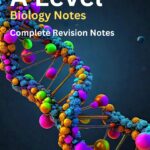 A Level Biology Notes
A Level Biology Notes
A Level Biology Notes are study materials specifically crafted to help students studying A-level Biology (typically in the UK or regions that follow similar academic systems) understand and retain key concepts. A-levels, short for "Advanced Levels," are advanced academic qualifications taken by students usually around ages 16-18. These notes serve to simplify complex topics, highlight important information, and help students grasp the depth of understanding needed to succeed in exams.
A Level Biology Notes generally include:
- Summaries of Core Topics: Covering areas such as cell biology, genetics, ecology, physiology, biochemistry, evolution, and more.
- Diagrams and Illustrations: Often featuring labeled diagrams to make complex biological structures and processes easier to visualize.
- Key Terms and Definitions: Lists of essential terms and definitions are highlighted to help with retention and understanding.
- Exam Tips and Practice Questions: Notes may include tips specifically aimed at preparing for exams, as well as practice questions to reinforce understanding.
- Condensed Information for Revision: Concise explanations help students quickly revise the most important aspects before exams.
These notes can be in various formats, such as digital files, textbooks, or as part of online courses.
Candidates for Cambridge International A Level Biology study the AS topics and the following topics:
8 units
·
148 lessons
|
Last updated: November 22, 2024
|
Please login to save the post
Notes
Flashcards
Questions
MCQ Quiz
Exam Study Notes
8 units
·
148 lessons
9 topics
16 topics
14 topics
4 topics
16 topics
4 topics
14 topics
3 topics
7 topics
5 topics
2 topics
4 topics
4 topics
7 topics
3 topics
6 topics
7 topics
6 topics
11 topics
4 topics
2 topics
Flashcards
Will be Added soon.....
MCQ Quiz
3 found this helpful out of 4 votes
Helpful: 75%
Helpful: 75%
Was this page helpful?
